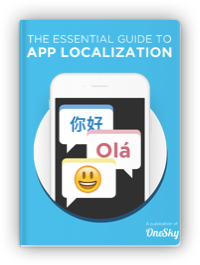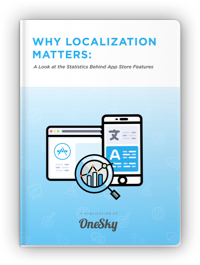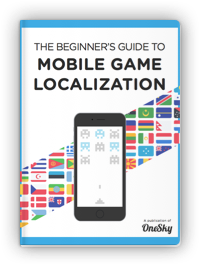Automated Translation Updates: Boost Your Global Content
Automated translation updates are transforming how businesses manage multilingual content today.
As companies expand globally, delivering accurate and current content in multiple languages is essential—but doing this manually is slow, costly, and often impractical.
AI-powered automated updates make it easy to keep websites, apps, and documents fresh, relevant, and culturally appropriate—automatically and in real-time.
In this article, you’ll discover why automated translation updates are a necessity in today’s fast-paced world, how they work under the hood, and best practices for implementation.
- Why Automated Translation Updates Are Necessary
- Benefits of Using Automated Translation Updates
- How Automated Translation Works
- Strategic Advice for Implementing Automated Translation
- Exploring Pioneering Solution: OneSky Localization Agent
- Overcoming Common Challenges in Automated Translation
- The Future of Automated Translation and OLA’s Role
- Step-by-Step: Getting Started with Automated Translation Updates
- Final Thoughts: Unlock Global Success with Automated Translation
Why Automated Translation Updates Are Necessary
1. The Need for Fast, Ongoing Localization
Gone are the days of one-off translations. Today’s content—product info, updates, campaigns—changes constantly.
To stay competitive, businesses must update content quickly across all languages. Manual translation is slow and costly, risking outdated or inconsistent info.
Automated updates allow brands to deliver real-time, accurate translations everywhere.
This supports agile localization, keeping your content fresh and relevant, and improving customer engagement and loyalty.
2. Growing Multilingual Content Demands
More companies want to reach customers in their native language.
According to CSA Research, over 75% of online shoppers prefer buying in their language and might abandon a site if content isn’t localized. Sectors like e-commerce, travel, and media see huge benefits from multilingual content.
Without automation, managing rapid content growth is overwhelming.
Manual translation struggles with volume, speed, and consistency.
Automation handles large volumes efficiently, ensuring timely, uniform messaging worldwide.
3. Boosting SEO and Customer Engagement
Multilingual SEO means more than translation—it’s about keeping content updated with keywords, metadata, and hreflang tags.
Outdated content drops in search rankings, reducing visibility and traffic.
Automated updates keep SEO elements fresh and competitive. This drives more organic visitors and boosts conversions.
Plus, customers trust brands that regularly deliver localized, accurate content—building loyalty and trust in the process.
Read also: Localization Strategy: Everything You Need to Know
Benefits of Using Automated Translation Updates
1. Faster Content Delivery
Manual translation processes can delay the launch of new features, products, or marketing campaigns by weeks.
This delay can cause significant opportunity losses, especially in industries where timing is crucial.
Automation reduces this timeline significantly.
With systems like OneSky Localization Agent (OLA), businesses can update and deploy multilingual content within hours, ensuring all global audiences receive timely and accurate information at the same moment.
This rapid deployment is particularly beneficial during high-stakes events like product launches or crisis communications.
2. Consistent and High-Quality Translations
Maintaining consistency in terminology and style across languages is crucial for brand integrity.
Errors or mismatched translations can confuse customers and harm brand perception, leading to lost trust and revenue.
Systems like OLA use AI-driven translation memories and glossaries that ensure terminology stays consistent across all content.
This AI support, combined with optional human review for critical content, ensures both accuracy and consistency, preserving the brand’s voice and quality.
3. Cost Savings
Translation costs can add up quickly, especially with many languages or frequent updates. Manual work requires teams of translators and reviewers, increasing expenses.
Automated systems reduce costs. After setup, they handle updates in many languages with little human effort, helping companies grow globally without high extra costs.
4. Enhanced User Experience
Today’s users want content that speaks their language and reflects their culture.
Automated translation updates help deliver personalized experiences by showing relevant, culturally adapted content to every user, no matter where they are.
- Localized User Interfaces: Immediate translation updates for UI elements ensure that your software or platforms deliver consistent experiences.
- Engaging, Culturally Relevant Content: Automated systems make it easier to reflect local customs, idioms, and societal norms in your content, creating a more engaging interaction for the user.
- Increased Trust and Loyalty: Continuous delivery of culturally sensitive content builds trust and fosters customer loyalty, turning one-time buyers into repeat, devoted customers.
5. Improved SEO and Market Reach
Automated translation updates also contribute significantly to improved SEO rankings.
By continuously refining and updating multilingual content:
- Consistent Use of Hreflang Tags: Ensures that search engines understand which geographic region a page is targeting.
- Up-to-Date Metadata: Keeps your metadata fresh and relevant, improving search engine visibility across different regions.
- Localized Keyword Strategy: Automated updates adjust keyword strategies in real-time according to local trends, optimizing content for search engines in each market.
- Higher Ranking and Increased Traffic: These enhancements contribute to higher rankings in local search results, drawing more organic traffic.

How Automated Translation Works
The ability to efficiently and accurately translate content across different languages and locales relies on several sophisticated processes and technologies:
Key Components of Automated Translation
- Neural Machine Translation (NMT)
- How it Works: NMT uses advanced algorithms and deep learning models to understand and translate entire sentences as a whole, rather than word-by-word.
- Benefits: This approach produces more natural, fluent translations that better capture the context and intent of the source material.
- Translation Memories & Glossaries
- Purpose: They are databases of previously translated phrases and terminology.
- Functionality: Ensures consistency by reusing existing translations and maintaining uniformity in terminology and style across all translated content.
- Content Management System (CMS) Integration
- Advantage: Direct integration with your CMS allows for seamless updates, ensuring that new or changed content is automatically translated and published without manual intervention.
- Quality Assurance & Continuous Learning
- Monitoring: Automated systems continuously monitor translation quality and gather feedback to improve over time.
- Learning Mechanisms: Feedback is used to refine the system’s translation models, ensuring ongoing enhancements in accuracy and contextual understanding.
Here’s how an automated translation update cycle typically works:
| Step | Description | Role of OLA |
|---|---|---|
| 1. Detection | Monitors for changes in source content. | Automatically identifies and flags updated content. |
| 2. Translation Process | Generates initial translations using NMT. | Utilizes leading translation engines for high-quality results. |
| 3. Human Review | Optional review for specific critical content. | Integrates professional editors where needed for nuanced content. |
| 4. Publication | Publishes translated content across platforms. | Syncs updates with your CMS or web platform. |
| 5. Feedback Loop | Collects feedback and errors for continuous improvement. | Real-time dashboards and analytics for ongoing optimization. |
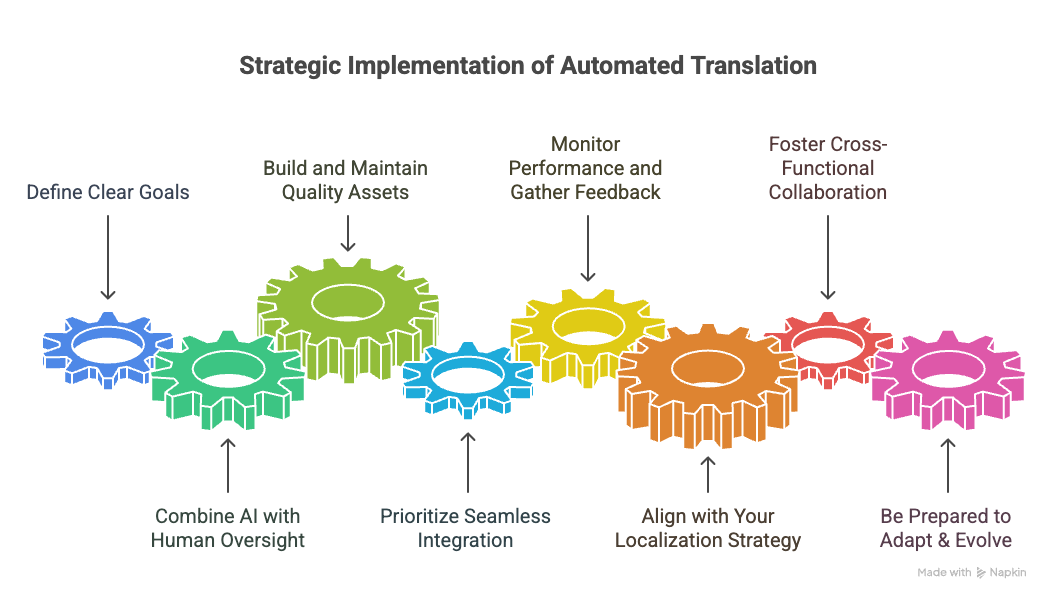
Strategic Advice for Implementing Automated Translation
Implementing automated translation isn’t just about technology—it’s about strategy.
To get the most out of your investment, keep these best practices in mind:
1. Define Clear Goals
Identify what you want to achieve with automation.
Are you aiming for faster content updates, better consistency, cost savings, or improved SEO? Clear goals help you choose the right tools and measure success effectively.
2. Combine AI with Human Oversight
While automation speeds up workflows, certain content—like branding messages, legal documents, or high-stakes marketing—requires a human touch to ensure cultural relevance and accuracy.
Use a hybrid approach: automate routine translations, but review critical material with professional linguists.
3. Build and Maintain Quality Assets
Create comprehensive glossaries, style guides, and translation memories tailored to your brand and industry.
Regularly update them based on feedback, new terminology, and evolving content.
This groundwork helps your AI produce consistent, high-quality translations aligned with your brand voice.
4. Prioritize Seamless Integration
Choose systems with robust APIs and flexible workflows that can connect effortlessly with your existing content management and development tools.
Automate the repetitive tasks of content updates, but retain control over key content, setting up review or approval steps where necessary.
5. Monitor Performance and Gather Feedback
Use analytics dashboards to track translation accuracy, consistency, and speed.
Solicit feedback from both users and translators to identify issues.
Regularly review and refine your glossaries, workflows, and AI models based on performance data to continuously improve output quality.
6. Align with Your Localization Strategy
Ensure your automation efforts support your broader goals, whether it’s expanding into new markets, improving user experience, or boosting SEO.
Focus on high-impact content first, then scale gradually.
Planning content priorities helps maintain quality and resource efficiency.
7. Foster Cross-Functional Collaboration
Success depends on cooperation between technical teams, marketing, content creators, and linguists.
Regular communication ensures everyone stays aligned on terminology, style, and content goals, leading to more effective automation.
8. Be Prepared to Adapt & Evolve
AI technology is constantly improving.
Stay informed about new features, models, and best practices.
Be flexible—update your processes and assets as needed to keep up with advancements and changing market demands.

Exploring Pioneering Solution: OneSky Localization Agent (OLA)
Why Choose OLA?
The landscape of automated translation tools is crowded, but it offers distinct advantages:
| Feature | Why It Matters | How OLA Excels |
|---|---|---|
| Multi-Agent Orchestration | Combines multiple AI engines for layered, high-quality results | Coordinates multiple translation models for best outputs |
| Seamless Integration | Fits into your existing tech stack | Supports popular CMS, APIs, development workflows |
| Transparency & Control | Provides real-time insight into processes | Dashboards show translation status, quality, and feedback |
| Continuous Learning | Keeps up with evolving language trends | Incorporates latest models, feedback, and updates automatically |
| Privacy & Compliance | Protects sensitive company data | Fully GDPR and CCPA compliant |
How OLA Works in Practice
Imagine you have a multilingual website with frequent updates. With OLA:
- The system detects when a webpage or app UI element has changed.
- It automatically triggers translation via multiple AI engines.
- Human reviewers are notified for high-stakes content.
- The updated translation is published directly into your CMS.
- Managers see real-time dashboards reporting on progress and quality.
- Feedback loops improve future translations.
This tightly integrated process allows your global content to stay fresh, accurate, and engaging—without the bottlenecks of manual workflows.
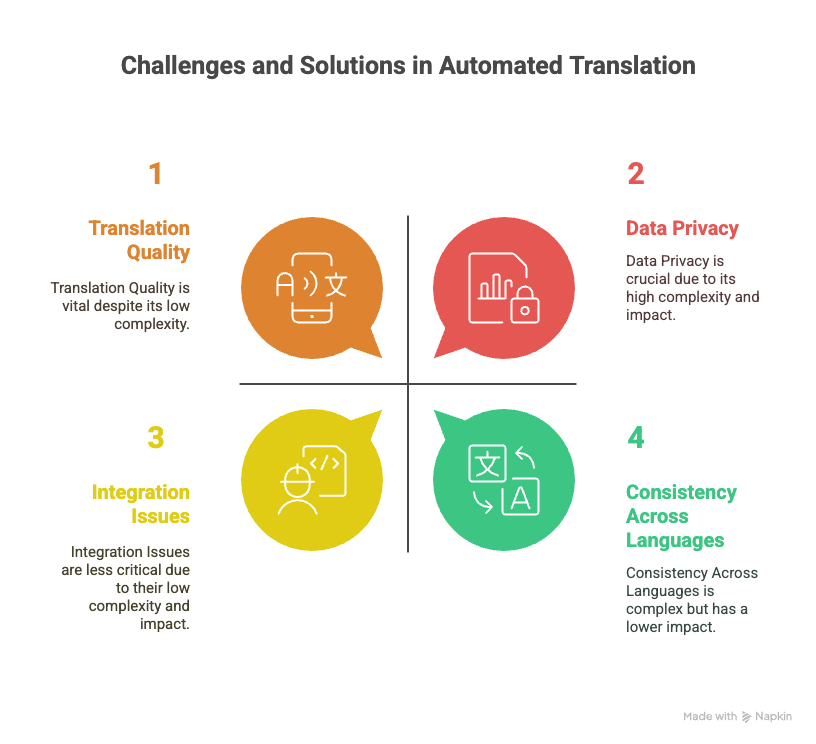
Overcoming Common Challenges in Automated Translation
Automation offers many benefits, but it can also come with challenges.
Here are some common issues and simple solutions:
1. Translation Quality
Problem: AI may give awkward or incorrect translations.
Solution: Use AI for basic content, but have important content reviewed by human experts. Keep your terminology and style guides updated so the AI learns your preferences.
2. Consistency Across Languages
Problem: Translations may vary, confusing customers.
Solution: Use translation memories and glossaries to keep key terms consistent. Regular checks help ensure quality.
3. Data Privacy
Problem: Sensitive data needs protection.
Solution: Choose secure platforms that follow privacy laws like GDPR. Ensure data is encrypted and access is controlled.
4. Integration Issues
Problem: Connecting new tools to your existing systems can be tricky.
Solution: Use platforms with strong APIs and start with small projects to test the setup before full rollout.
5. Balancing Automation and Human Review
Problem: AI isn’t perfect for everything.
Solution: Automate routine content but review high-stakes or complex content with professional translators to ensure accuracy.

The Future of Automated Translation and OLA’s Role
1. Rapid Advances in Artificial Intelligence
The field of AI has moved quickly, especially with the development of large language models (LLMs) like GPT-4 and beyond.
These models are capable of understanding complex contextual cues, idioms, slang, and cultural subtleties far better than previous systems.
- Improved Contextual Understanding: AI can now interpret the intent behind words and phrases, resulting in translations that sound more natural and native.
- Content Generation: Future systems will generate multilingual content from scratch—creating headlines, product descriptions, or social media posts automatically, tailored to different regions or audiences.
- Continual Learning: These models will keep getting smarter as they process more data, feedback, and user interactions, ensuring your translations grow more accurate over time.
2. Smarter, Context-Rich Translations
The future of translation is not just about words but also about understanding the full context—images, videos, or even cultural references embedded within content.
- Multi-Modal Models: New AI systems will incorporate visual cues, audio, and other multimedia elements to produce richer, more nuanced translations.
- Cultural Sensitivity: These models will better grasp local humor, customs, and taboos, avoiding missteps or cultural insensitivity.
How OLA Is Preparing:
The flexible architecture of OLA’s multi-agent system ensures it can incorporate these emerging innovations seamlessly, maintaining your content’s relevance and accuracy across regions.
3. Increased Personalization & Dynamic Localization
In the next decade, content will become increasingly personalized, adapting instantly to user preferences or context.
- Real-Time Content Adaptation: For example, an e-commerce site could automatically offer personalized product recommendations, tailored headlines, or localized promotions, all translated and delivered instantly.
- Localized User Experience: Websites, apps, or social media channels will dynamically change language, tone, or cultural references to suit individual users.
Industry Impact:
This level of personalization will improve customer satisfaction, boost conversions, and foster deeper brand loyalty.
4. Broader Industry Adoption and Integration
More companies will recognize the benefits of AI orchestration platforms like OLA, leading to widespread adoption across industries:
| Industry | Expected Benefits | How OLA Supports |
|---|---|---|
| E-commerce | Faster product launches, frequent updates | Continuous multilingual product catalogs |
| Software & SaaS | Real-time UI updates, documentation localization | Seamless integration for agile development cycles |
| Media & Publishing | Instant news translation, multimedia localization | Real-time news feeds & social media posts |
| Travel & Hospitality | Dynamic content for travel guides, booking engines | Instant translation of dynamic website content |
| Healthcare | Multilingual patient info, research sharing | Secure, compliant content updates with high accuracy |
As these technologies become mainstream, they’ll enable more flexible, consistent, and cost-effective localization approaches that can grow with your business.
Read also: Agentic AI Translation: Exploring The Future of Translation

Step-by-Step: Getting Started with Automated Translation Updates
If your organization is ready to adopt automated translation, here’s a step-by-step guide:
1. Conduct a Content Audit
Identify what content is most critical or most frequently changed:
- UI Strings: buttons, labels, menus
- Product Descriptions: e-commerce, software features
- Support Content: FAQs, help articles
- Marketing Content: landing pages, blogs, emails
Focus on content that impacts customer experience the most and update frequently.
2. Define Clear Goals and KPIs
What do you want to achieve?
- Faster release cycles
- Better translation consistency
- Cost reduction
- Higher SEO rankings
Set measurable KPIs:
- Turnaround time for updates
- Translation accuracy scores
- Traffic improvements in local markets
- Customer satisfaction ratings
3. Select a Trusted Platform (like OLA)
Evaluate platforms that provide:
- Easy integration with your website, app, or content hub
- Multi-agent AI orchestration
- Feedback and review management
- Security and compliance
Why OLA?
It orchestrates AI modules, integrates seamlessly with your systems, and provides full transparency—giving you control over your multilingual content.
4. Build and Maintain Localization Assets
Create glossaries, style guides, and terminology databases that reflect your brand voice and industry language.
- Regularly update these based on user and reviewer feedback.
- Use AI-assisted tools to automatically generate or suggest updates to these assets.
5. Run a Pilot Program
Select a small content area, such as website UI strings or social media posts, to test the automation process.
- Monitor the translation quality and turnaround times.
- Gather feedback from users and linguistic reviewers.
- Make improvements based on findings.
6. Scale Up and Optimize
Once the pilot proves successful:
- Expand automation to more content types and languages.
- Use dashboard data to improve quality.
- Keep updating your assets, and retrain AI models for better results.
7. Maintain & Improve Your System
Automation isn’t a set-it-and-forget-it solution.
To maximize its benefits:
- Regularly review dashboards: Monitor translation quality, speed, and accuracy.
- Update glossaries & style guides: Keep terminology and tone aligned with evolving brand standards.
- Gather user and reviewer feedback: Use this data to retrain AI models, refine workflows, and improve translation quality.
- Stay up to date on AI advancements and platform features: Incorporate the latest language models and tools for continuous improvement.
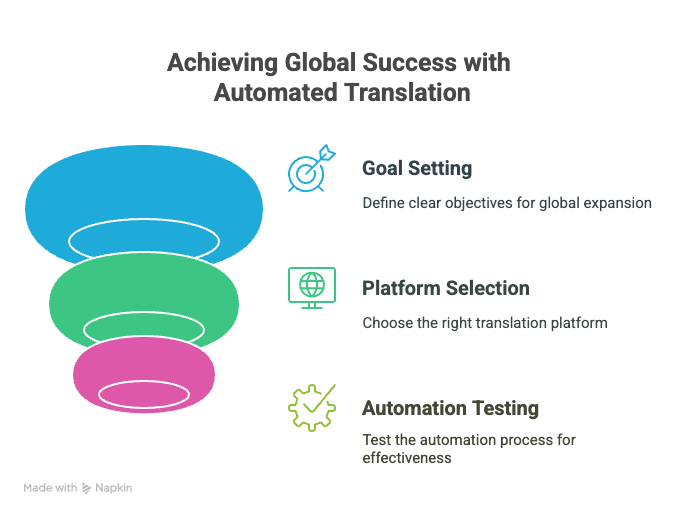
Final Thoughts: Unlock Global Success with Automated Translation
Automation is key to growing worldwide. It helps you stay flexible, save costs, and deliver high-quality content in many languages.
Solutions like OneSky Localization Agent (OLA) make it easy. They coordinate AI engines, fit into your workflow, and keep getting better.
Whether launching products, managing a multilingual website, or supporting customers, automation makes your international growth faster and more reliable.
Start now—review your content, set goals, pick a platform, and test automation.
The sooner you act, the more competitive you’ll be.
In today’s connected world, speed and trust matter. Investing in automated translation isn’t just smart—it’s essential.
As AI advances, early adopters will lead their industries and grow globally.
Get in touch today to unleash your full international potential with OneSky Localization Agent!
Frequently Asked Questions
Q1: What are automated translation updates?
Automated translation updates use AI technology to automatically translate and update multilingual content across websites, apps, and documents in real time.
This ensures your content stays fresh, accurate, and localized without manual effort.
Q2: Why should my business use automated translation updates?
They help you respond quickly to market changes, reduce translation costs, ensure consistency across all languages, and improve your SEO rankings.
Automation keeps your content current and relevant worldwide.
Q3: How does the process work?
Content updates trigger the system to automatically generate translations via advanced AI engines.
Human review can be added for high-stakes content, then updates are published directly to your websites or platforms, seamlessly and instantly.
Q4: What platforms support automated translation updates?
Many modern content management systems and localization platforms support automation, including WordPress, Drupal, and custom APIs.
Leading solutions like OneSky Localization Agent (OLA) orchestrate multiple AI engines for optimal results.
Q5: Is human review necessary?
While AI provides fast, accurate translations, human review remains important for critical, branded, or culturally sensitive content.
Many systems support human-in-the-loop workflows to ensure quality.
Q6: How much does automation cost?
Once set up, automation significantly reduces ongoing translation expenses by minimizing manual work.
Costs depend on the platform, content volume, and complexity—but overall, automation offers substantial savings.
Q7: Can automation improve my SEO?
Yes. Automated updates ensure your metadata, hreflang tags, and localized keywords stay current.
This boosts your visibility in local search results and attracts more organic traffic from global markets.
Q8: How does AI-driven translation improve over time?
With ongoing feedback and continuous learning, AI models get smarter, producing more accurate and culturally appropriate translations.
This adaptive process ensures your multilingual content keeps improving.
Q9: How do I start using automated translation updates?
First, identify your most updated content, then choose a platform that works with your systems.
Run a small test to see how it performs, gather feedback, and gradually expand. Starting small helps you refine the process for better results.

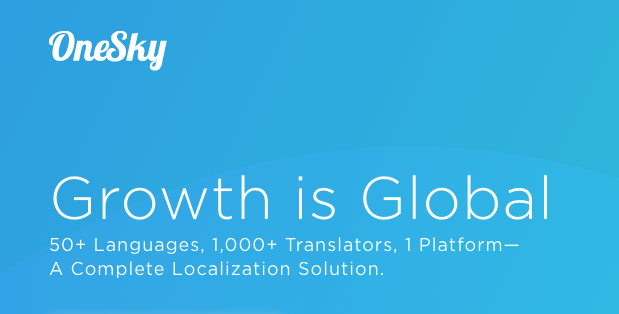



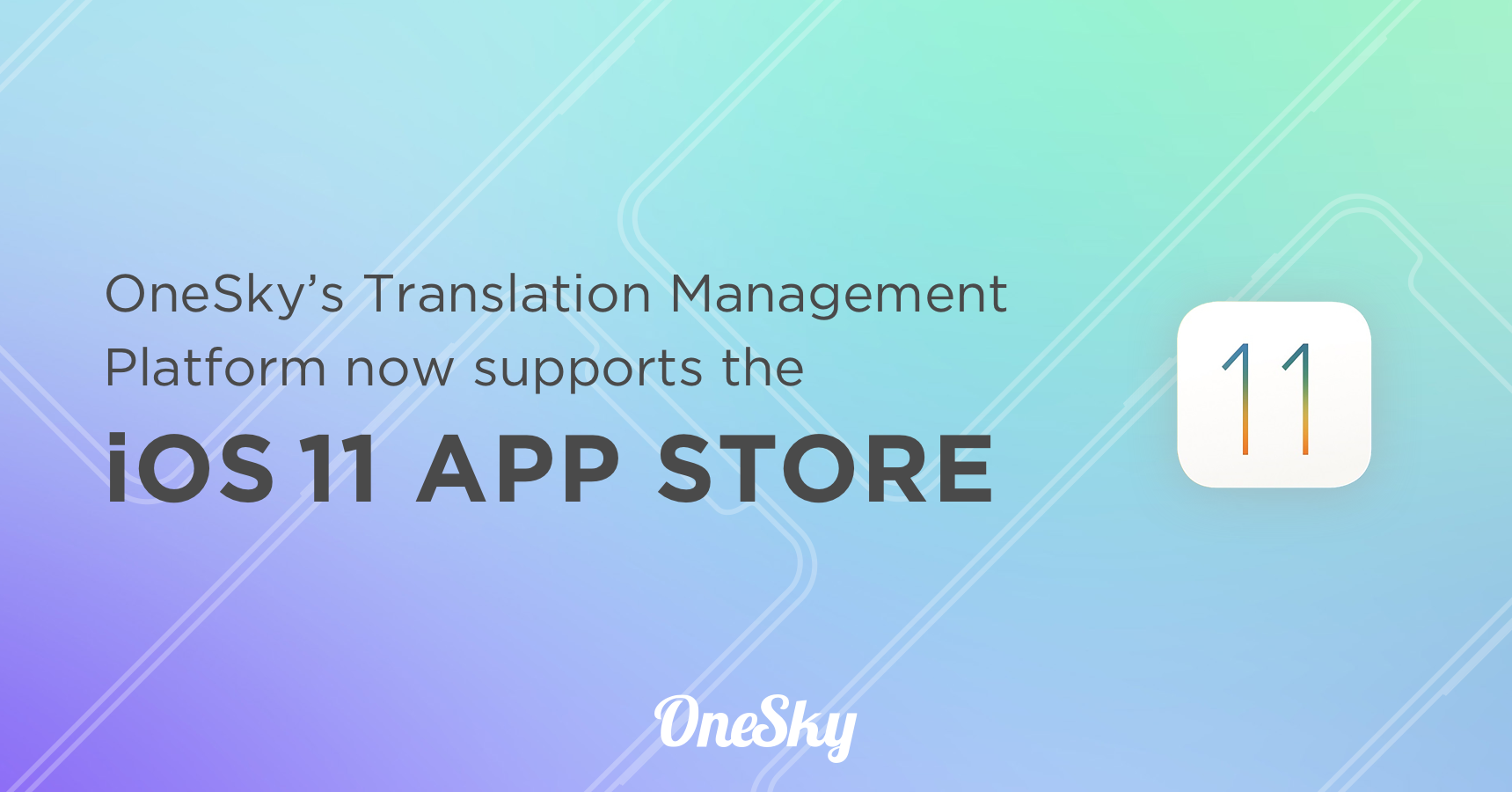
 Written by
Written by 
